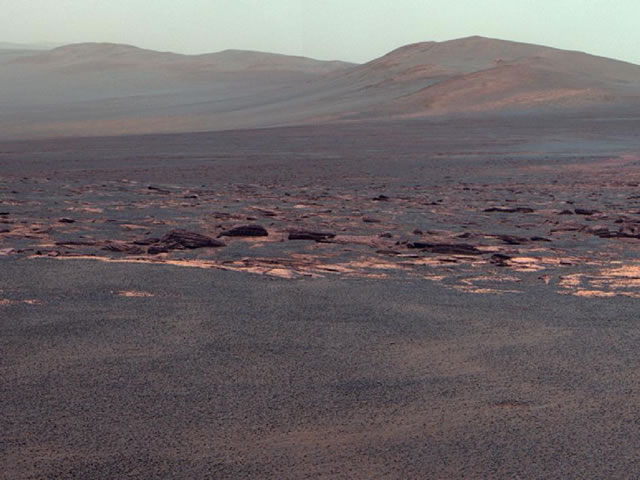The Mars rover Opportunity has now reached the edge of a 14 mile wide crater NASA scientists announced on Wednesday. It has taken the solar-powered six wheel rover three years to reach the Endeavor Crater. It drove up 13 miles from a smaller crater called Victoria.
 West Rim of Endeavour Crater on Mars. Image Credit: NASA
West Rim of Endeavour Crater on Mars. Image Credit: NASA
The robotic geology tool in the rover will now be used to examine rocks older than any it has seen in its seven years on the surface of the red planet. In the years that Opportunity has spent on Mars it has studied sulfate sediments that pointed to an environment that was once wetter and warmer.
Opportunity had a twin rover called Spirit which fell silent last year. The location that Opportunity reached on Wednesday has been dubbed Spirit Point in honor of its twin.
John Callas of NASA's Jet Propulsion Laboratory is the project manager of the project which saw both Opportunity and Spirit land on Mars in 2004. Callas said that NASA was treating this stage in the life of Opportunity as a brand new mission. Scientists via Opportunity will now be able to study more of the planet’s past as the layers of materials from ages ago are exposed in the crater.
“Our arrival at this destination is a reminder that these rovers have continued far beyond the original three-month mission,” said John Callas.
The study of these rocks is part of a NASA Mars Exploration Program called “Follow the Water.” Essentially the scientists are looking for further proof that liquid water existed or still exists on the planet. Water is needed a pre-requisite for potential life to develop.
Earlier this month observations from NASA's Mars Reconnaissance Orbiter revealed possible flowing water during the warmest months on Mars. Imagery from the Orbiter showed dark, finger-like features appearing and extending down some Martian slopes during late spring through summer, fading in winter, and then returning during the next spring. Repeated observations have tracked the seasonal changes in these recurring features on several steep slopes in the middle latitudes of Mars' southern hemisphere.